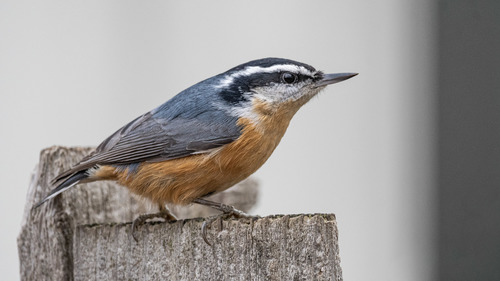
Red-breasted Nuthatch
The Red-breasted Nuthatch (Sitta canadensis) is a small, energetic songbird known for its distinctive nasal calls and its ability to climb headfirst down tree trunks. It plays a crucial role in forest ecosystems by controlling insect populations. This species is not particularly significant in human culture, but its unique behaviors and striking appearance make it a favorite among birdwatchers.
10-11 cm
Length
16-18 cm
Wingspan
Least Concern
Conservation Status
Distribution
Found across North America, from southern Alaska and Canada to the northern United States. Some populations are resident, while others migrate south for the winter, reaching as far as the Gulf Coast and northern Mexico. They are primarily found in coniferous forests.
Lifespan
Average lifespan in the wild is around 2 years, but some individuals can live up to 7 years.
Red-breasted Nuthatch's Habitat
Habitat Types
Coniferous forests, Mixed woodlands
Climate Zones
Boreal, Temperate
Adaptations
Strong claws and legs allow them to climb headfirst down tree trunks, a unique foraging adaptation among North American birds. Their bill is sharp and slightly upturned, ideal for probing bark for insects.
Variations
No recognized subspecies, but slight variations in plumage and vocalizations may occur across their extensive range.
Appearance
Breeding Plumage
Plumage remains similar year-round.
Seasonal Feather Changes
No Significant Seasonal Variation
Sex Based Plumage Differences
Males have a black cap and a black eyeline separated by a white supercilium. Females have a grayer cap and eyeline. Both sexes have a reddish-brown breast.
Notable Features
Reddish-brown breast, Black or gray cap, Black eyeline, White supercilium
Diet and Feeding
Primary Foods
Insects, Spiders, Conifer seeds
Foraging Behavior
Forages actively on tree trunks and branches, often hanging upside down. They glean insects and spiders from bark crevices and cones. They also cache seeds for later consumption.
Specializations
Strong claws and legs enable their unique headfirst climbing ability. Their bill is well-suited for extracting seeds from cones.
Seasonal Diet Variations
Diet shifts with availability. Insects are predominant in the summer, while conifer seeds are crucial in winter.
Behavior
Social Structure
Generally found in pairs or small family groups. They may join mixed-species foraging flocks in winter.
Communication
Distinctive nasal 'yank-yank' call, Variety of other calls and songs, especially during breeding season
Migration
Some populations are resident, while others undertake short- to medium-distance migrations. Irruptive migrations can occur in years with poor cone crops.
Territorial or Group Behaviors
Territorial during the breeding season, defending their nesting cavity and surrounding foraging area. Less territorial during the non-breeding season.
Conservation
Threats
Habitat loss due to logging, Climate change (affecting cone production), Spruce budworm outbreaks (which can both increase and decrease food availability)
Protection Programs
Sustainable forestry practices, Monitoring of populations through bird surveys
Local National Laws
Protected under the Migratory Bird Treaty Act in the United States and Canada.
Population Trend
Stable
Population Estimates
Global population estimated at 18 million individuals.
Interesting Facts
They often smear pitch around the entrance of their nest cavity.
This is thought to deter predators and competitors.
They can remember the locations of thousands of cached seeds.
This is crucial for surviving the winter when insects are scarce.
They move down trees headfirst.
This behavior is fairly unique and helps them to notice food sources that other birds may miss.
Faqs about Red-breasted Nuthatch
What do Red-breasted Nuthatches eat?
They eat insects, spiders, and conifer seeds, varying their diet with the seasons.
Where do Red-breasted Nuthatches nest?
They nest in tree cavities, either natural ones or old woodpecker holes.
Are Red-breasted Nuthatches migratory?
Some populations are resident, while others migrate south for the winter. Some years they exhibit irruptive migrations based on food availability.
How can I attract Red-breasted Nuthatches to my yard?
Provide conifer trees, offer sunflower seeds and suet at feeders, and consider installing a nest box.
Copyright @ Nature Style Limited. All Rights Reserved.
 English
English